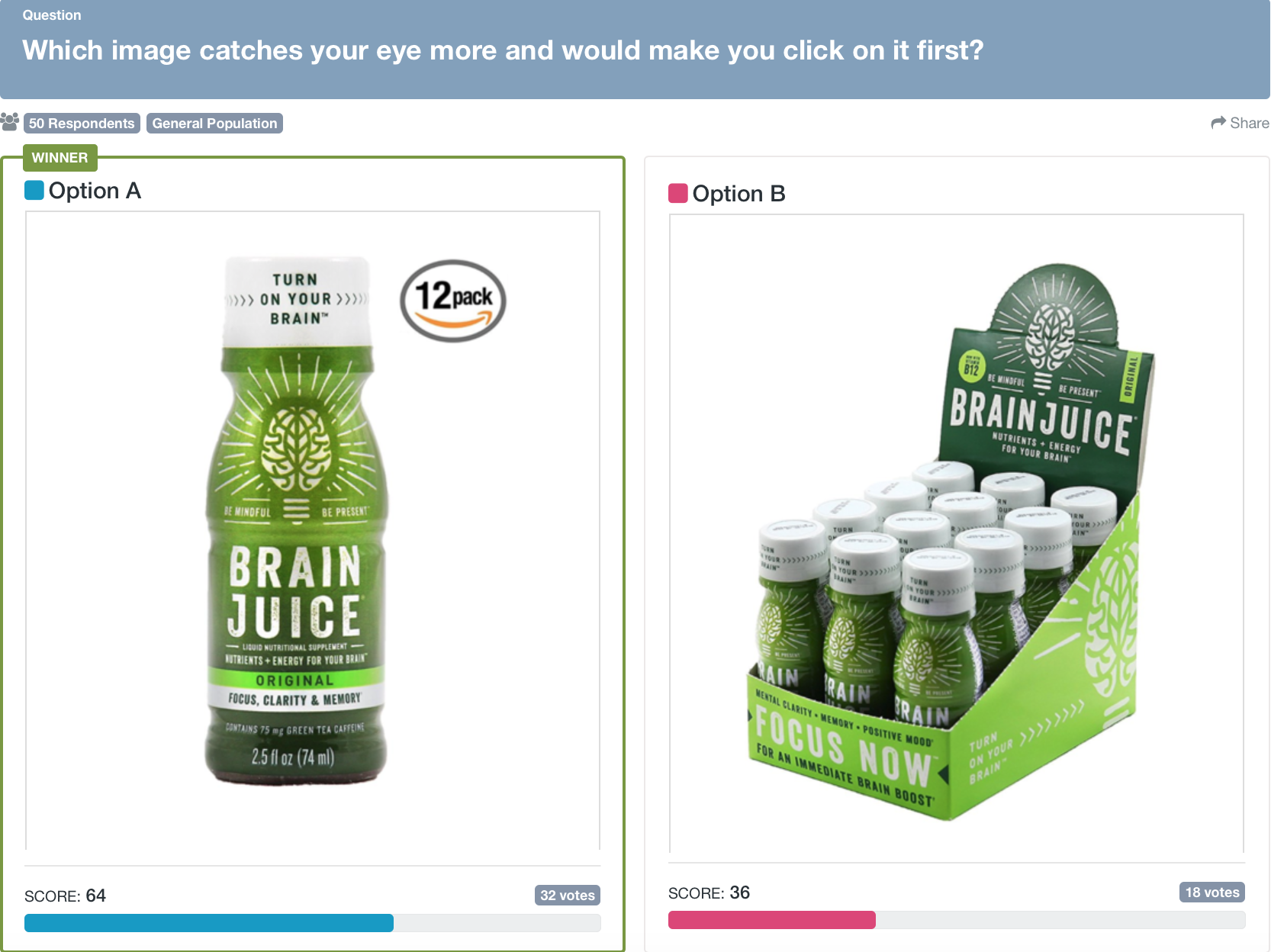Meet the interviewer
The EcomHub Podcast, run by e-commerce entrepreneurs Tom Wang and David Zaleski, discusses anything and everything to do with e-commerce. They talk shop about Facebook marketing, email marketing, Amazon selling, and everything in between.
They’ve used PickFu before for their own businesses, so when David met PickFu co-founder John Li at the 2018 Internet Retailers Conference + Exhibition, or IRCE, in Chicago, they decided to keep in touch.
Read on for interview highlights, or listen to the entire interview here.
How a longtime PickFu user utilizes polling
Longtime PickFu user David Zaleski began the interview by asking John Li to explain a bit more about what PickFu is.
Basically, John said, PickFu is a crowdsourcing polling platform that pulls from a pool of over 10,000 respondents. A brand can test almost anything on PickFu, from product packaging to main images and everything in between.
A selection of respondents then vote on their favorite option and provide a snippet of detailed feedback as to why they chose it.
Zaleski finds PickFu a deeply useful tool because, as an Amazon seller, you have to go through a lot of steps. Once you’ve got your brand name pinned down, you have to create a logo. And then there’s product packaging to think of. Main images. Listing descriptions.
A lot of these essential elements are visual things that make a difference online or even in a brick-and-mortar shop.
PickFu enables you to split-test different versions of your product. You can pick your ideal audience, too. For example, Zaleski, as an Amazon seller, often split-tests two photos and chooses an audience of Amazon Prime members to respond to his poll. If he’s testing a product
Then you can pick anywhere from 50 to 500 people to vote on your poll.
These split-tests are pretty quick, Li added. As little as 15 minutes for a 50-person poll or a couple hours for a more refined poll, and you’ll be done.
Why PickFu polling matters
The reason Zaleski finds PickFu so useful? Because often, you think that something is going to work, but then you run the poll, and it turns out it’s the opposite. What you thought your audience would love, they hate. Or vice versa. And your audience doesn’t lie.
The neat thing about PickFu is respondents will tell you exactly why they like or don’t like Option A or B (or C or D).
Li added that most of the time sellers find those comments just as useful or more useful than the votes. After adjusting their listing according to the written feedback, sellers often come back and run subsequent polls to make sure everything’s shipshape.
David Zaleski agreed, adding that he and Tom Wang used PickFu when they were picking out their logo. They knew they wanted to do EcomHub but didn’t know what to use for the logo, so they ran two different tests. One for how EcomHub should be spelled.
Then they split-tested the color for their logo. Their options were yellow, yellow and black, and gold and black. Zaleski was sure gold and black would look best, but PickFu respondents liked the yellow so that’s what they went with. People seem to love the branding thanks to PickFu.
PickFu is more helpful than a traditional split-test because you get the numbers much more quickly. Respondents may not be your existing customers, but they’re people in your demographic.
The importance of split-testing product packaging
In today’s world, businesses have to focus on branding, including product packaging. That’s all people really see. The first main image in your packaging makes a big difference. Split-testing that will pay itself off quickly, said Zaleski, adding that you’re better off fronting a little payment for PickFu, which can pay itself off in a day, than in risking unappealing product packaging.
John Li brought up a case study of Kevin King, a PickFu user who calls using PickFu his #1 seller’s hack.
A client of his, Brain Juice, was debating which image to use on an Amazon listing: A single bottle of the Brain Juice supplement or an image of a 12-pack, which is what customers get when they make a purchase.
During a conference in Hong Kong, King showed the audience a PickFu poll he created to test the two images — without showing them the results. He asked them which image they would choose.
80 percent of sellers in the audience chose Option B. But the respondents in the PickFu poll wanted to see the label close up, not the entire package, as in Option A. After running this PickFu poll, BrainJuice’s click-through rate (CTR) went up 40 percent. They changed nothing about their product listing but the image. The next month, overall product sales went up 35 percent — an amount of about $2,600. The PickFu poll they ran only cost $50.
In short, it was well worth the money to test those images on PickFu.
Li brought up another case study about a client he just met at IRCE, Thrasio, a portfolio fund that buys Amazon FBA businesses. They try to identify good products on FBA, and then come in, buy, and optimize. They found PickFu at IRCE and told them how much they used polling to test different aspects of their businesses’ products.
For example, they had a product in the pet odor neutralizer space. They had purchased it and it converted well, but the branding wasn’t great. So they had their design team iterate all kinds of ways to present the name, the label, and so on.
Then they started running PickFu polls to whittle the choices down. After a couple different polls, they went with the winner PickFu respondents chose. They sent PickFu the graph of how May vs April looked for that product.
PickFu helped increase the unit session rate from 40 to 45, and the increase in sales was equal to million a year run rate with this single product.
David Zaleski, impressed, told listeners that every company should be split-testing when it comes to packaging and design.
It can be the difference between succeeding or shutting down the business. And if what you’re selling is a liquid or supplement, you can really stand out with the right images, branding, and packaging.
Who are the respondents?
Next, Zaleski asked, “When you run these polls, who are the people who are voting on this stuff?”
John Li replied that PickFu sources its panel from a bunch of online polling panels. They ensure they are U.S.-based and then add a layer of demographic targeting, asking, “Are you an Amazon Prime member? Tell us more about yourself.” The more information they give, the more PickFu can share relevant polls. The respondents get paid for their replies.
To ensure the quality of the responses, PickFu has several quality control systems: for example, customers can rate each answer, after which PickFu will go through the system to make sure low-quality respondents get flagged. Anyone who runs a PickFu poll can either vote up or down. If you flag a response, PickFu will look into respondents, warn them, and take action to remove them from the system if needed.
Still curious, Zaleski asked if this was a full-time gig for some people.
Li said that most respondents answer polls on the side. They’re often stay-at-home parents or people who have desk jobs. They’ll actually answer polls during quiet times at their computers.
Even PickFu uses PickFu
Next, David asked if John Li and the others at PickFu use the service themselves.
PickFu actually used PickFu to find the right name. Li and his colleagues read all the comments respondents gave. They wanted to choose a name available as a domain that was also catchy but not offensive.
Now that they have the perfect name, PickFu uses PickFu all the time for marketing ads, feature names, and more.
Using PickFu for non-visual purposes
A good chunk of PickFu customers use PickFu to test visual elements of their products and listings. But, Zaleski asked, can PickFu be beneficial for other things, such as price? Sales copy? Emails?
While it isn’t the primary use, Li said, they have seen plenty of sophisticated sellers who test product page copy, bullet points, and listing titles.
They’ll also do competitive testing. One guy basically took a scree
PickFu also sees other large companies, not in e-commerce, who split-test different marketing layouts before every single newsletter.
People can split-test email subject lines, blog post titles, email layouts, Facebook ads, and even YouTube thumbnails. Influencers can use PickFu to test images for Instagram. Real estate agents can split-test photos of homes for sale.
And while you can test up to eight things at once, many sellers like to test one thing. They link to a product listing or website page and solicit open-ended feedback, asking, “How compelling is this? Do you have any questions?”
This gives you directional information for what you need to improve on your listing.
David Zaleski ended the interview by telling the audience they must split-test because their competition probably isn’t doing it. Even if you’re on a small budget, make it happen. At least test your product images and packaging, and you will make the money back within 3-4 days.
For any questions, John Li invited listeners to email him at john@pickfu.com.



